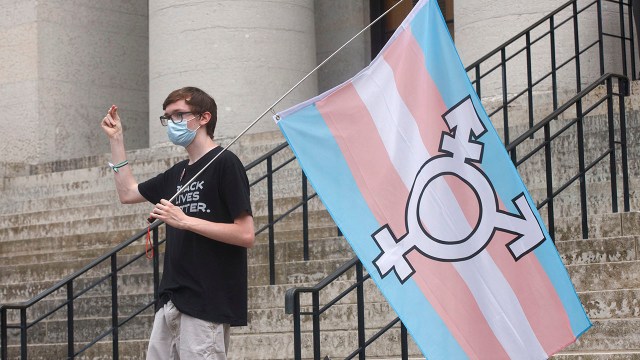
At a time when transgender and nonbinary Americans are gaining visibility in the media and among the public, a new Pew Research Center survey finds that 1.6% of U.S. adults are transgender or nonbinary – that is, their gender differs from the sex they were assigned at birth.
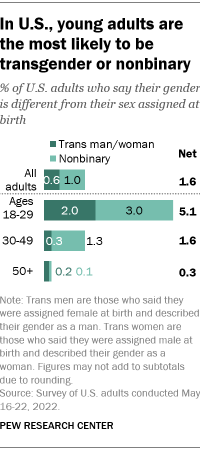
Meanwhile, a rising share of Americans say they know someone who is transgender. This analysis accompanies an essay that examines the experiences and views of trans and nonbinary adults based on a series of focus groups.
Adults under 30 are more likely than older adults to be trans or nonbinary. Some 5.1% of adults younger than 30 are trans or nonbinary, including 2.0% who are a trans man or trans woman and 3.0% who are nonbinary – that is, they are neither a man nor a woman or aren’t strictly one or the other. (Due to rounding, subtotals may not add up to the total.) This compares with 1.6% of 30- to 49-year-olds and 0.3% of those 50 and older who are trans or nonbinary.
The share of U.S. adults who are transgender is particularly high among adults younger than 25. In this age group, 3.1% are a trans man or a trans woman, compared with just 0.5% of those ages 25 to 29. There is no statistically significant difference between these two age groups in the share who are nonbinary or the total share who are trans or nonbinary.
Pew Research Center conducted this study to estimate the share of Americans whose gender is different from the sex they were assigned at birth. The study also explores the share of Americans who know someone who is transgender and the share who know someone who is nonbinary. These findings are part of a larger survey of the general public on their attitudes about gender identity and issues related to people who are transgender or nonbinary. Other survey results will be released later this summer.
This analysis accompanies findings from six focus groups that study the experiences and views of transgender and nonbinary adults.
This analysis is based on a survey of 10,188 U.S. adults. The data was collected as a part of a larger survey conducted May 16-22, 2022. Everyone who took part is a member of the Center’s American Trends Panel (ATP), an online survey panel that is recruited through national, random sampling of residential addresses. This way, nearly all U.S. adults have a chance of selection. The survey is weighted to be representative of the U.S. adult population by gender, race, ethnicity, partisan affiliation, education and other categories. Read more about the ATP’s methodology. Here are the questions used for this analysis, along with responses, and its methodology.
A rising share of adults say they know a transgender person
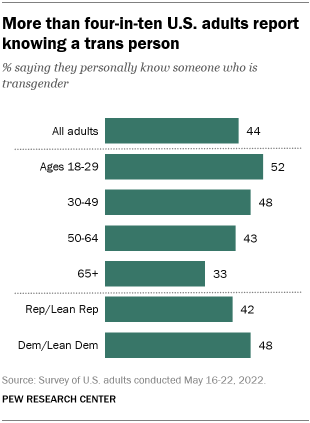
While a relatively small share of U.S. adults are transgender or nonbinary, many say they know someone who is. More than four-in-ten (44%) say they personally know someone who is trans and 20% know someone who is nonbinary.
The share of adults who know someone who is transgender has increased from 42% in 2021 and from 37% in 2017.
Today, roughly half of adults younger than 30 and those 30 to 49 say they know a trans person – higher than the share among older Americans. Still, a third of those 65 and older report knowing someone who is trans.
Democrats and independents who lean to the Democratic Party are more likely than Republicans and Republican leaners to say they know a transgender person, but Republicans are catching up. As recently as June 2021, 48% of Democrats said they knew a trans person, compared with 35% of Republicans – a gap of 13 percentage points. Today, 48% of Democrats and 42% of Republicans say this – a gap of just 6 points.
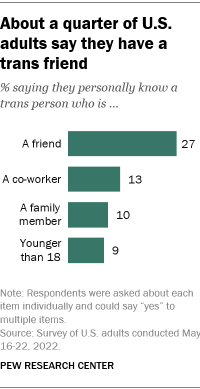
About a quarter of U.S. adults say they have a trans friend (27%), while 13% say they have a co-worker who is trans and 10% say they have a transgender family member. About one-in-ten adults (9%) say they know a trans person who is younger than 18.
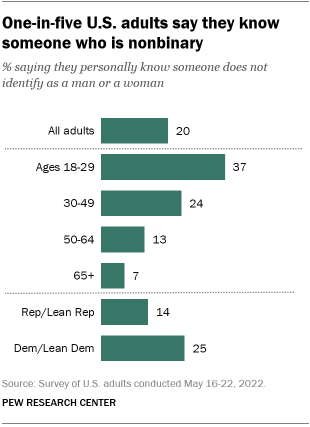
When asked if they know someone who doesn’t identify as a man or a woman, 20% of U.S. adults say they do. The share is higher among younger adults, those living in urban and suburban communities, those with higher levels of education, and Democrats.
Most Americans (79%) say they have heard at least a little about people not being a man or a woman and instead describing themselves as not having a gender or using terms such as “nonbinary” or “gender fluid” to describe their gender. But only 26% say they have heard a lot about this concept.
Young adults are far more likely to be familiar with this than their older counterparts. About four-in-ten adults younger than 30 (42%) say they have heard a lot about being nonbinary, compared with 31% of those 30 to 49, 20% of those 50 to 64 and 12% of those 65 and older. Still, even older adults have at least some passing familiarity with the idea: Two-thirds of those 65 and older say they have heard at least a little.
A 2021 Pew Research Center survey found that 26% of U.S. adults personally knew someone who goes by gender-neutral pronouns such as “they” instead of “he” or “she,” up from 18% in 2018.
Note: Here are the questions used for this analysis, along with responses, and its methodology.
